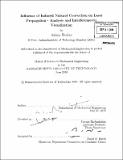| dc.contributor.advisor | George Barbastathis. | en_US |
| dc.contributor.author | Bhakta, Aditya (Aditya S.) | en_US |
| dc.contributor.other | Massachusetts Institute of Technology. Dept. of Mechanical Engineering. | en_US |
| dc.date.accessioned | 2011-03-07T15:19:49Z | |
| dc.date.available | 2011-03-07T15:19:49Z | |
| dc.date.copyright | 2010 | en_US |
| dc.date.issued | 2010 | en_US |
| dc.identifier.uri | http://hdl.handle.net/1721.1/61590 | |
| dc.description | Thesis (S.M.)--Massachusetts Institute of Technology, Dept. of Mechanical Engineering, 2010. | en_US |
| dc.description | Cataloged from PDF version of thesis. | en_US |
| dc.description | Includes bibliographical references (p. 111-116). | en_US |
| dc.description.abstract | This thesis analyzes the influence of a self-induced natural convection flow on the propagation of a high energy laser beam. The two configurations considered are of a vertical laser beam (propagation direction opposite to gravity) and a horizontal laser beam (gravity acting in a direction perpendicular to propagation) traveling through an infinite expanse of quiescent fluid. Hamiltonian optics is used to predict the evolution of rays at steady state. The change in refractive index due to localized heating of the fluid by the laser is measured using interferometry. For the vertical laser beam, one model considers the beam to be a linear energy source. Another model considers the spatial intensity distribution of the beam as a generation term in the energy conservation equation. Simulation for both the models predict the formation of a caustic, as the beam propagates through the medium. Due to radial symmetry, there is a dense packing of rays along the periphery of a circle. Here, this formation is referred to as the thermal ring. The horizontal laser beam is first modeled as a linear source of uniform strength along the propagation path. The change in temperature is calculated using a similarity solution, and the resulting refractive index change predicts the ray behavior. Here again, formation of a caustic is suggested, with a high density of the rays at two locations above the beam centre. Modeling of the laser as a decaying line source also predicts the densing of rays. The thermal lensing caused by a horizontal 120mW laser in a 1% aqueous Toluidine Blue sample is visualized using a Mach-Zehnder interferometer. The interferograms are analyzed using both the Fourier methods and phase shifting. Both predict the change in refractive index near the beam to be of the same order of magnitude as the simulation results. | en_US |
| dc.description.statementofresponsibility | by Aditya Bhakta. | en_US |
| dc.format.extent | 116 p. | en_US |
| dc.language.iso | eng | en_US |
| dc.publisher | Massachusetts Institute of Technology | en_US |
| dc.rights | M.I.T. theses are protected by
copyright. They may be viewed from this source for any purpose, but
reproduction or distribution in any format is prohibited without written
permission. See provided URL for inquiries about permission. | en_US |
| dc.rights.uri | http://dspace.mit.edu/handle/1721.1/7582 | en_US |
| dc.subject | Mechanical Engineering. | en_US |
| dc.title | Influence of Induced natural convection on laser propagation : analysis and interferometric visualization | en_US |
| dc.type | Thesis | en_US |
| dc.description.degree | S.M. | en_US |
| dc.contributor.department | Massachusetts Institute of Technology. Department of Mechanical Engineering | |
| dc.identifier.oclc | 703905127 | en_US |
